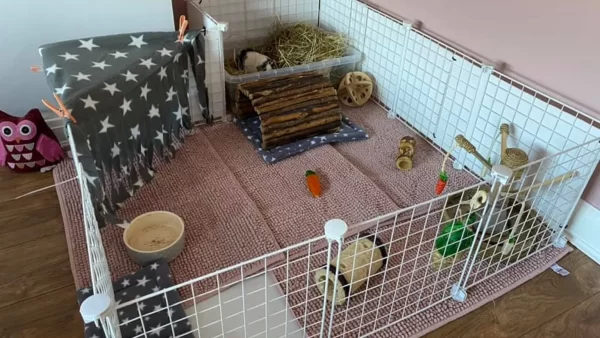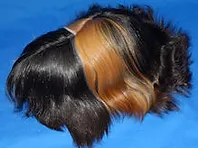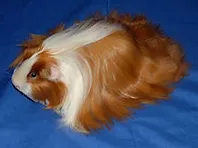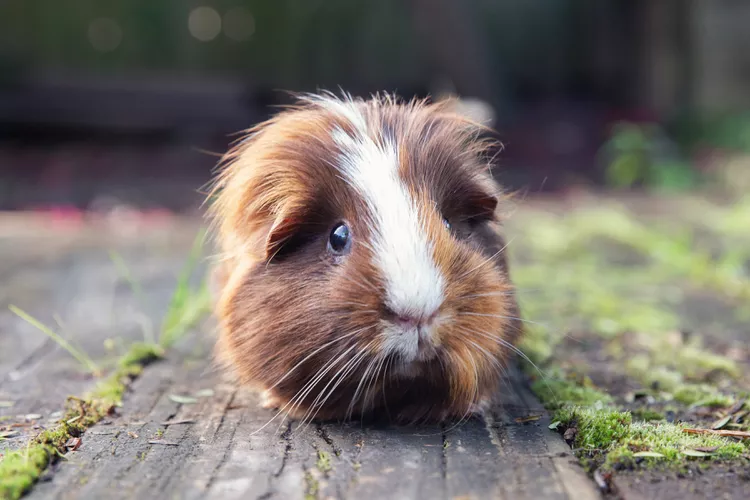Guinea Pigs, Cavia porcellus, are crepuscular rodents that are popular pets around the world. They were domesticated for food in the Andes mountains in Peru and Chile around 5000 BCE, but have since been viewed as pets and bred for looks rather than food
Personality:
Guinea pigs are inquisitive and friendly creatures. Once they trust you, they may lick and groom you, eat with you close by, or sleep on or near you. Guinea pigs sleep only 4 hours a day and are most active at dawn and dusk.
As social creatures, guinea pigs show their emotions in expressive ways. When excited, guinea pigs may “popcorn”, or jump in a new direction suddenly. They make sounds called “wheeking” when excited or greeting someone. Wheeking can be loud as the pigs want to make their affection known.
Unlike cats, guinea pigs purr when they distrust something or do not like a situation. A long purr is called rumble-strutting and can be used by males to show off for a female or a female wanting to mate. It can also be used as a warning in herds of guinea pigs before a fight starts.
Diet:
Guinea pigs are unable to produce Vitamin C for themselves. To ensure their health, they need pellet food, fresh vegetables, and fresh hay. In pellet food, added vitamin C is quickly lost when the food is opened and exposed to air. This results in the need for fresh hay and veggies.
Pellets are hay-based with added nutrients and should be fed in ⅛ cup portions. Timothy, orchard, or alfalfa hay are the typical options for hay for guinea pigs. Timothy and orchard hay are best for adult pigs, but alfalfa hay is recommended for young guinea pigs to supplement their calcium intake as well. Alfalfa shouldn’t be fed extensively to adults due to its higher sugar content.
In terms of vegetables and fruits, guinea pigs enjoy most leafy vegetables, but should not be fed fatty foods, sugary foods, or animal products. Root vegetables and foods high in calcium should only be fed in moderation. A complete list of what can be fed is found at: Southern California Guinea Pig Rescue
Housing:
The Humane Society of the United States recommends that one guinea pig should have at least 7.5 square feet of continuous space. Their recommended cage size for two guinea pigs is at least 10.5 square feet. Many guinea pig rescues also require this before adopting out their pigs. Any guinea pig enclosure should be well-ventilated and open for the guinea pig to see, smell, and hear their surroundings.
Cages can be purchased from pet stores like Petco, but they are consistently too small, per size recommendations. To ensure a proper size for the pigs, a cage can be made with wire storage cubes, zip ties, and a coroplast base, but it can be put directly on any hard surface.

Environment:
Inside a pig cage, there should always be access to fresh water, access to pellets, access to hay, places to hide, toys, and soft and absorbent bedding. These will ensure a healthy and safe environment for the pig(s).
Fresh water should always be available in a bottle attached to the side of the cage and checked regularly. Water bowls can quickly become unsafe to drink out of and leave the pig(s) without access to fresh and safe water.
Their pellets can be fed either in a bowl or scattered throughout the cage. It is easier to monitor how much food the pigs have eaten with a bowl, but scatter-feeding their food can provide enrichment and prevent boredom. These methods
Since pigs need hay to maintain a balanced diet, it can either be in a hay rack or put in a pile in the corner of the cage. Either way, they should have fresh hay that hasn’t been soiled.
Like any creature, guinea pigs can be scared by their environment and need hides to feel safe and sleep. These hides should have multiple entrances so that they cannot be cornered. Grass tunnels make excellent hides as well as being safe to chew on. For enrichment and to help maintain dental health, guinea pigs need toys to chew on. Grass mats and wood chews are easy to find and fun additions to any guinea pig cage.

Bedding:
As for bedding, there are several options available for purchase. Wood shavings, paper bedding, newspaper or corn cob pellets, paper shavings, and fleece liners. Not all of these options are safe for guinea pigs.
Most wood shavings, paper bedding, newspaper bedding, corn cob pellets, and paper shavings pose certain hazards to the
guinea pig’s health. Softwood shavings like untreated pine and cedar contain toxic phenols for guinea pigs. They also do not absorb pee, can hide large amounts of bacteria, and are prone to excess dust, which damages the guinea pig’s lungs and trachea. Paper bedding is also not absorbent and can have harmful dust particles similar to wood shavings.
Hardwood shavings like aspen and kiln-dried pine have fewer negative effects than softwood shavings, but they are still prone to dust and are not absorbent. Hardwoods and kiln-dried pine shavings have had some of the toxins removed so they are safer for use with animals.
One of the best bedding types for guinea pigs is quality fleece coverings that can be easily removed and replaced when soiled. Depending on the construction of the pad, there are different levels of absorbency, which can negatively affect the overall cleanliness of the guinea pig cage if there is excess pee being tracked around the cage.
https://guineadad.com/blogs/news/best-bedding-for-guinea-pigs
General Care:
Guinea pigs are generally hardy creatures with the exception of their sensitive respiratory systems and susceptibility to fungal infections. Using proper bedding will help maintain a clean environment free from bacteria and respiratory irritants.
If the guinea pig is a long-furred breed, you may need to brush it regularly to prevent matting. The Coronet, Peruvian, Peruvian Satin, Silkie, and Silkie Satin are all long-furred guinea pig breeds.
 Coronet
Coronet  Peruvian
Peruvian
 Peruvian Satin
Peruvian Satin  Silkie
Silkie
 Silkie Satin https://www.acbaonline.com/
Silkie Satin https://www.acbaonline.com/
Short-furred guinea pigs also enjoy brushing from people they trust and it helps with bonding between owner and pet.
Conclusion:
Guinea pigs are very unique creatures and it is clear why they make excellent pets. As with any animal you want to take care of, you need to make sure they are the right fit for you. Guinea pigs are a long-term commitment, but if you take care of them correctly, they will reward you times over.
Sources:
https://www.humanesociety.org/resources/guinea-pig-housing
https://www.rspca.org.uk/adviceandwelfare/pets/rodents/guineapigs
https://cherished-cavies.weebly.com/
https://guineadad.com/blogs/news/best-bedding-for-guinea-pigs
https://www.smallpetparade.com/shy-or-social-guinea-pig-personalities-and-behaviors/






